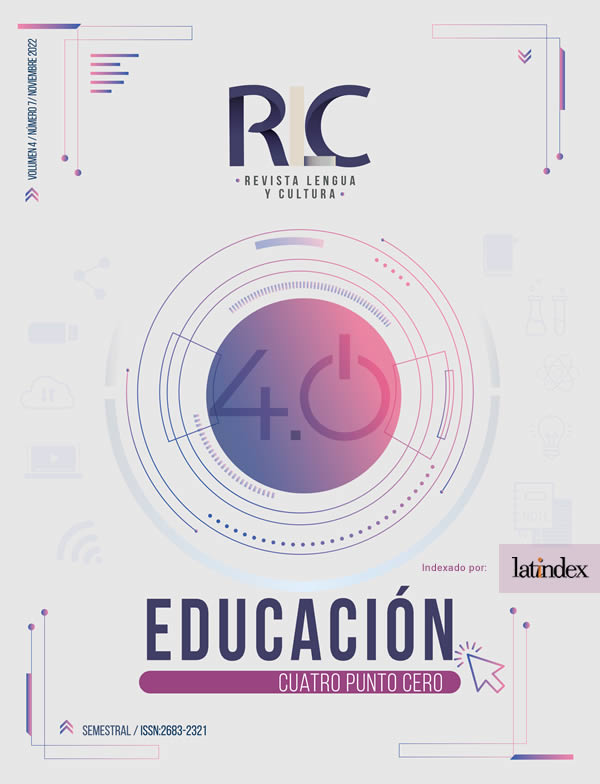La English lexical competence among university students in Mexico
Abstract
The present study focuses on investigating a dimension of lexical competence: the receptive vocabulary size in English of 345 university students in Mexico. The Vocabulary Size Test (VST) by Nation and Beglar (2007) of 100 questions was adapted, allowing estimates of up to 20,000 words. The general results indicate that university students have an average receptive vocabulary of 11,367 words and that they follow a linear pattern according to their self-perceived level of English. The VST turned out to be a valid and reliable instrument to determine not only lexical competence, but also the language proficiency.
Downloads
References
Referencias
Akbarian, I., y Alavi, S. (2013). Comparing the contribution of vocabulary breadth to IELTS and TOEFL reading subsets. Porta Linguarium, 20, pp.133-151. DOI: 10.30827/Digibug.27171.[2] Beglar, D. (2009) A Rasch-based validation of the Vocabulary Size Test. Language Testing, 26 (4) 1–22. doi:10.1177/0265532209340194.
Brown, H. D. (2004). Language Assessment: Principles and Classroom Practices. White Plains, NY: Pearson Education.
Caro, K. y Rosado, N. (2017). Lexis, Lexical Competence and Lexical Knowledge: A Review Journal of Language Teaching and Research, 8(2), 205-213, DOI: http://dx.doi.org/10.17507/jltr.0802.01.
Chapelle, C. A. (1994). Are C-tests valid measures for L2 vocabulary research? Second Language Research, 10(2), 157–187. doi:10.1177/026765839401000203
Chen, C., y Liu, Y. (2020). The role of vocabulary breadth and depth in IELTS academic reading tests. Reading in a Foreign Language, 32(1), 1-27. https://doi.org/10125/66574
Council of Europe (2001). Common Framework of Reference for Languages: Learning, Teaching, Assessment. Cambridge: Cambridge University Press. https://rm.coe.int/16802fc1bf
Crossley, S. A., Salsbury, T., & McNamara, D. S. (2012). Predicting the proficiency level of language learners using lexical indices. Language Testing, 29(2), 243–263. https://doi.org/10.1177/0265532211419331
Elgort, I. (2013). Effects of L1 definitions and cognate status of test items on the Vocabulary Size Test. Language Testing, 30(2), 253-272. https://doi.org/10.1177/0265532212459028.
Gyllstad, H. (2012). Validating the vocabulary size test. A classical test theory approach. Presented at the Ninth Annual Conference of EALTA, May, Innsbruck. Retrieved from www.ealta.eu.org/conference/2012/posters/Gyllstad.pdf
Haja M. (2012) Demonstrating Lexical Competence in Language Use. British Journal of Humanities and Social Sciences, 6(2), 79-85. http://www.ajournal.co.uk/HSpdfs/HSvolume6(2)/HSVol.6%20(2)%20Article%208.pdf
Harkio, N., y Pietilä, P. (2016) The Role of Vocabulary Breadth and Depth in Reading Comprehension: A Quantitative Study of Finnish EFL Learners
Journal of Language Teaching and Research, 7(6), DOI: http://dx.doi.org/10.17507/jltr.0706.03
Henriksen, B. (1999). Three dimensions of vocabulary development. Studies in Second Language Acquisition, 21(22), 303-317. doi:10.1017/s0272263199002089
Jiménez-Catatán, R. (2002) El concepto de competencia léxica en los estudios de aprendizaje y enseñanza de segundas lenguas. Atlantis, 14(2), pp. 149-162. https://dialnet.unirioja.es/servlet/articulo?codigo=759791
Laufer, B. (1992). How much lexis is necessary for reading comprehension? En Vocabulary and Applied Linguistics, Eds. P. Arnaud, y H. Be’joint, (126–32). London: Macmillan.
Lewis, M. (1993). The Lexical Approach. Hove: Language Teaching Publications.
Lewis, M. (2008). Implementing the Lexical Approach: Putting Theory into Practice. Hampshire: Heinle CENGAGE Learning.
Marin-Marin, A. (2005) Extraversion and the use of vocabulary learning strategies among EFL university learners in Mexico. Unpublished PhD Dissertation. Colchester: University of Essex. https://www.researchgate.net/publication/33994819_Extraversion_and_the_use_of_vocabulary_learning_strategies_among_university_EFL_students_in_Mexico
Meara, P. 1996. “The dimensions of lexical competence”. En Performance and competence in second language acquisition, G. Brown, K. Malmkjaer, Y J. Williams, (eds), 35–53.
Cambridge: Cambridge University Press.
Meara, P., y Jones, G. (1990). Eurocentre’s Vocabulary Size Test: User’s guide. Zurich: Eurocentres.
Meara, P. (1996). The dimensions of lexical competence. In G. Brown, K. Malmkjaer, y J. Williams (Eds.), Performance and Competence in Second Language Acquisition (pp. 35-53). Cambridge: Cambridge University Press.
Miralpeix, I. y Muñoz, C. (2018). Receptive vocabulary size and its relationship to EFL language skills. International Review of Applied Linguistics in Language Teaching, 56(1), 1-24. https://doi.org/10.1515/iral-2017-0016
Nation, P. (1983). Testing and teaching vocabulary. Guidelines, 5, 1, 12-25.
Nation, P. (1990). Teaching and Learning Vocabulary. Boston: Heinle and Heinle.
Nation, P. (2012) Learning Vocabulary in Another Language. Cambridge: Cambridge University Press. https://doi.org/10.1017/CBO9781139524759
Nation, P., & Beglar, D. (2007). A vocabulary size test. The Language Teacher, 31, 9–13. https://www.lextutor.ca/tests/nation_beglar_size_2007.pdf
Nordquist, R. (2020). Lexical Competence. https://www.thoughtco.com/what-is-lexical-competence-1691114.
Palacios Martínez, I. (dir.), Alonso Alonso, R., Cal Varela, M., Calvo Benzies, Y., Fernández Polo, F., Gómez García, L., López Rúa, P., Rodríguez Rodríguez, Y. y Varela Pérez, J.. (2019). Diccionario electrónico de enseñanza y aprendizaje de lenguas. ISBN 978-84-09-10971-5. https://www.dicenlen.eu/es/diccionario/entradas/competencia-lexica.
Richards, J. (1976) The role of vocabulary teaching. TESOL Quarterly, 10, 77–89. http://www.jstor.org/stable/3585941
Schmitt, N., Schmitt, D., y Clapham, C. (2001). Developing and exploring the behaviour of two new versions of the Vocabulary Levels Test. Language Testing, 18, 55–88. doi:10.1191/026553201668475857.
Stæhr, L. (2008). Vocabulary size and the skills of listening, reading and writing. Language Learning Journal, 36(2), 139–152. https://doi.org/10.1080/09571730802389975.
The British National Corpus, version 2 (BNC World). 2001. Distributed by Oxford University Computing Services on behalf of the BNC Consortium. URL: http://www.natcorp.ox.ac.uk/
Webb, S. (2008). Receptive and productive vocabulary sizes of L2 learners. Studies in Second Language Acquisition, 30(01). doi:10.1017/s0272263108080042
Zareva, A., Schwanenflugel, P., y Nikolova, Y. (2005). Relationship between lexical competence and language proficiency: Variable Sensitivity. Studies in Second Language Acquisition, 27(04), 567-595. doi:10.1017/s0272263105050254
Copyright (c) 2022 Alfredo Marin-Marin; María Isabel Hernández-Romero

This work is licensed under a Creative Commons Attribution-NonCommercial-NoDerivatives 4.0 International License.













